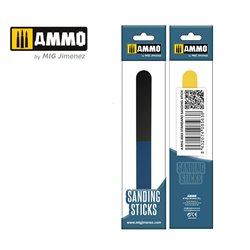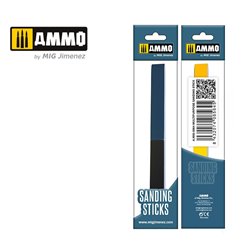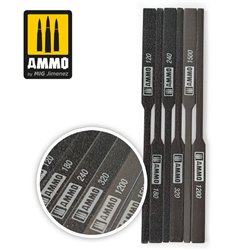A model clamp is a lightweight clamp (or series of smaller clamps) designed to hold the parts of a model together or...
No products
Product successfully added to your shopping cart
There are 0 items in your cart. There is 1 item in your cart.
Search Tips
What are the benefits of a multiple grit sanding stick?
Inevitably in most modelling projects, there is a requirement for the clean-up of parts prior to assembly. This may be as a result of imperfections left over from the moulding process, or simply as a result of unwanted plastic burrs when parts are cut from the sprue.
At this point, many modellers will choose to use a sanding stick to reduce or remove imperfections. Some manufacturers produce sanding sticks with a variety of grades of grit on their sanding sticks. These are designed specifically to remove unwanted effects and to ensure that parts are polished for better fit and to create a smoother surface.
A coarse grit surface will inevitably remove unwanted effects but may well leave a tell-tale roughened surface on any part. This is not always a bad thing as a slightly roughened surface may well help adhesives to gain better traction during parts assembly. However, this can be a problem when the roughened surface remains visible through subsequent paint layers, especially on exposed surfaces.
Multi-grit sandings sticks are specifically configured to deal with this specific issue. In most cases, the sanding stick will number its respective surfaces in numerical order. The coarser grit surfaces are used first to remove the obstruction, with each subsequent step utilising a gentler grain ensuring that a smooth finish is offered to the modeller. In effect, the first steps remove the obstruction, with the final steps polishing the part in question which should then leave the modeller with a smooth finish.
Some sanding sticks are numbered, clearly indicating the order of use. Others may display a numerical value indicating the grade of the grit. As a general rule the lower the number the coarser the grit, thus 180 grade is coarser than 600, whereas 2000 is incredibly smooth and would be ideal for final polishing.
Most sanding sticks will work on a variety of parts including injection moulded plastics and resins found in most kit parts. The higher grades are very forgiving and can also be used for final buffing, including on clear parts and transparencies.
Click here to receive the tips weekly in your mailbox. You can unsubscribe at any time.










